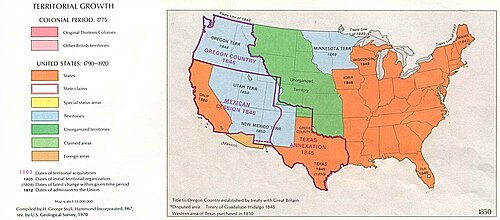Mexican Cession
Alta California and Santa Fe de Nuevo México were captured soon after the start of the war and the last resistance there was subdued in January 1847, but Mexico would not accept the loss of territory.
Although Mexico did not overtly cede any land under the treaty, the redefined border had the effect of transferring Alta California and Santa Fe de Nuevo México to the control of the United States.
[citation needed] The US Senate approved the treaty, rejecting amendments from Jefferson Davis to also annex most of northeastern Mexico and from Daniel Webster to decline to take Alta California and Santa Fe de Nuevo México.
[2] The Mexican Cession as ordinarily understood (i.e. excluding lands claimed by Texas) amounted to 525,000 square miles (1,400,000 km2), or 14.9% of the total area of the current United States.
Soon after the war started and long before negotiation of the new Mexico–United States border, the question of slavery in the territories to be acquired polarized the Northern and Southern United States in the bitterest sectional conflict up to this time, which lasted for a deadlock of four years during which the Second Party System broke up, Mormon pioneers settled Utah, the California Gold Rush settled California, and New Mexico under a federal military US government turned back Texas's attempt to assert control over territory Texas claimed as far west as the Rio Grande.
The topography of the New Mexico Territory included mountains that naturally directed any railroad extending from the southern Pacific coast northward, to Kansas City, St. Louis, or Chicago.



